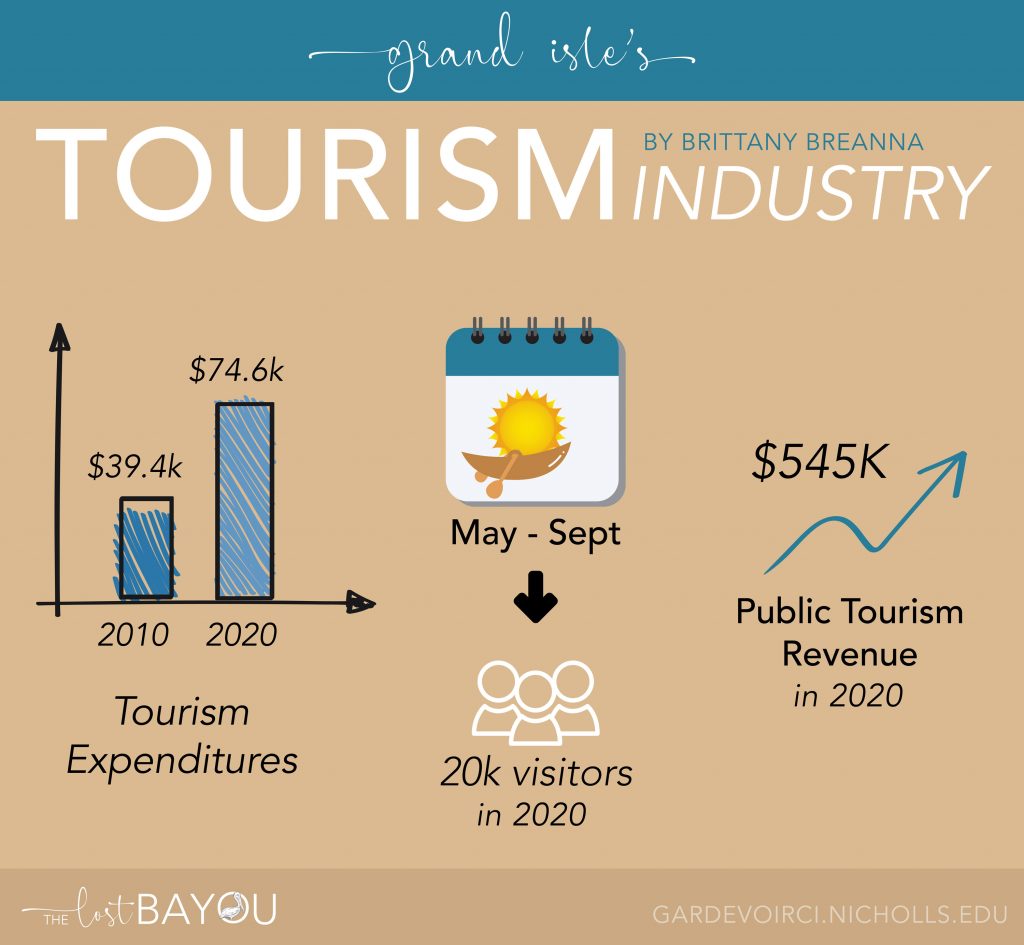By Alaina Pitre, staff writer
Grand Isle, Louisiana, is home to several industries including oil, seafood and fishing, tourism and several types of recreation like surfing and birding. Over time, natural and historical factors have caused significant shifts in these industries.
Located on the Gulf of Mexico, fishing and seafood are two prominent industries on the island. Grand Isle is home to the oldest fishing tournament in the United States, The Grand Isle Tarpon Rodeo, established in 1928.
“Commercial fishing is the livelihood of the town of Grand Isle,” says Weldon Danos, executive director of the Grand Isle Port Commission.
These industries attract tourists, making Grand Isle a common vacation destination to South Louisianians. Grand Isle’s tourism scene was established in the early 19th century, and it was mostly visited by South Louisiana’s wealthy planters and New Orleans’ elite.
In addition to economic shifts in Grand Isle’s industries, historical and environmental factors have made significant contributions to industry shifts. Some of the most impactful shifts are caused by erosion and hurricanes.
Rickey Collins, owner of Jo-Bob’s Gas & Grill and longtime Grand Isle resident, says that he has seen significant industry shifts in his time on the island.
“In the early eighties there was a massive oil field presence in Grand Isle,” Collins says. “It was a huge clientele for the island and now they’ve all left.”
Collins says big oil companies like Exxon and Conoco had bases and installations on the island. He says it was a big business for Grand Isle, but island business has now transitioned primarily into tourism.
According to Klaus Meyer-Arendt’s Annals of Tourism Research Volume: 12, Issue 3, Grand Isle’s industries can be divided into several developmental phases to define industry changes and shifts.
The first stage started in the 1820s and lasted about 70 years when a railroad connection shortened the travel time from New Orleans to Grand Isle, making the island more accessible. A notable business of this time span was The Ocean View Hotel, a luxurious, multi-facility resort that was completely destroyed by a hurricane in 1983.
The second stage, from 1893-1945, was geared more towards developing recreational activities. Not only was the Tarpon Rodeo born during this phase, but Highway 1 was also completed, allowing more automobile access onto the island. This period was also accompanied by more hurricane devastation, two world wars, and the Great Depression.
Post-war development in the 1950s was heavily impacted by shoreline erosion and beach deterioration due to hurricanes. Despite erosion control measures, this decline in development continued into the 1960s.. Devastating hurricanes such as 1965’s Betsy, 1985’s Danny, Elena, and Juan, 2005’s Katrina, 2008’s Gustav, 2021’s Ida, and many more have remained a consistent threat to Grand Isle and the flow of its industries.
As hurricanes continue to impact businesses as well as entire industries, Grand Isle residents feel the effects.
“It gets old after a while – it becomes hard,” Collins says. “Rates go up, some businesses and residents don’t recover and leave, and things change every time.”
Danos says the seafood and commercial fishing industry as a whole has lost around 1.2 billion dollars from Hurricane Ida’s impact. He says it will take years to fully recover from this loss.
“I think the industry is very strong-willed, and they are willing to come back,” Danos says. “They haven’t given up.”
Collins says the Grand Isle community is dedicated, even with its ever-changing culture.
Collins says, “We won’t give up unless the day comes where the government gives up on us.”

